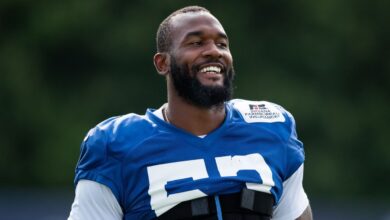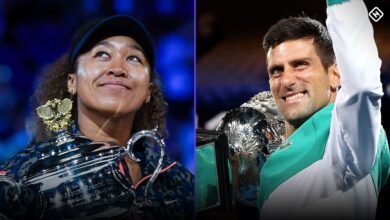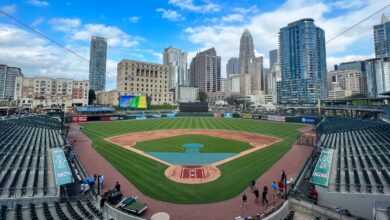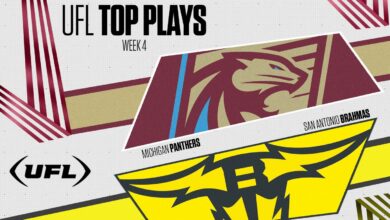O’s take Holliday No. 1 overall; Results and analysis for every first-round pick
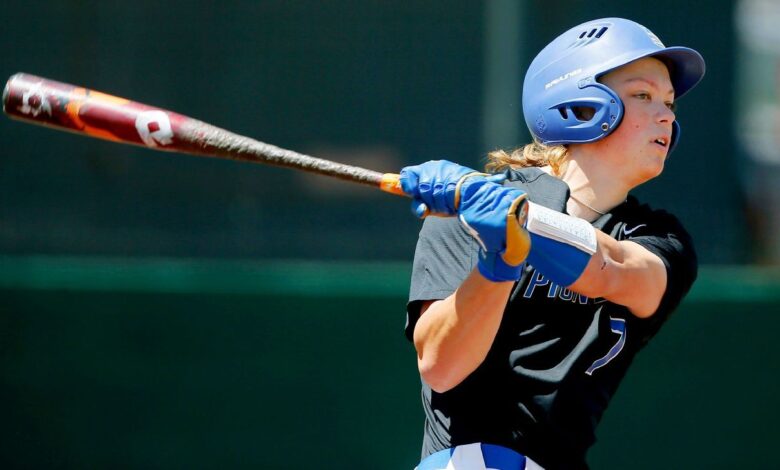
It’s 2022 MLB draft day in Los Angeles and the Baltimore Orioles have made their selection.
With the No. 1 overall pick, the Orioles took Jackson Holliday, top prospect and son of former major leaguer Matt Holliday. The Arizona Diamondbacks followed up with another son for a former major leaguer (Andruw), selecting Druw Jones.
The Texas Rangers shocked many by picking Kumar Rocker, one of the most well known names in the draft, at No. 3. The Pittsburgh Pirates took Termarr Johnson fourth overall and the Washington Nationals nabbed Elijah Green to round out the first five picks. The first 80 picks will be made Sunday night followed by Rounds 3-10 on Monday and concluding with Rounds 11-20 on Tuesday.
Which teams will make the picks that will surprise everyone? MLB experts Dave Schoenfield and Dan Mullen have everything you need to know about who your favorite team took on draft night.
7 p.m. ET: Watch the 2022 MLB draft on ESPN
![]() Mock draft 3.0 | 2.0 | 1.0
Mock draft 3.0 | 2.0 | 1.0
![]() Team-by-team draft guide: Fits, needs for all 30 teams
Team-by-team draft guide: Fits, needs for all 30 teams
![]() Ranking the top 300 MLB draft prospects
Ranking the top 300 MLB draft prospects
![]()
1. Baltimore Orioles: Jackson Holliday, SS, Stillwater HS (OK)
Who is Holliday? The son of a major league All-Star (Matt), Holliday has separated himself as the best prep shortstop in this class by way of his powerful bat. He hit .685 with 17 home runs, 79 RBIs and even stole 30 bases in 40 games during his high school season. There is a question of whether he can stick at shortstop or will end up moving to second base as a pro, but his offensive skill set will play at either position.
1:51
Jackson and Matt Holliday discuss the excitement around Jackson becoming the No. 1 pick in the 2022 MLB draft.
Why the Orioles took him here: After months of speculation that the Orioles could go a number of different ways with this No. 1 pick, Baltimore showed why by taking someone other than consensus No. 1 prospect Druw Jones here. Now the big question is if Baltimore will be able to sign Holliday at any savings and then use the savings to go over slot on players at its later picks tonight (Nos. 33 and 42).
In Holliday, the Orioles are getting an elite talent who has risen up draft boards steadily this spring thanks to his array of quality tools and projection at the plate. Holliday joins a group of recent top draft prospects currently making their way toward Baltimore as the O’s come out of their rebuild. — Mullen
![]()
2. Arizona Diamondbacks: Druw Jones, CF, Wesleyan HS (GA)
Who is Jones? The No. 1 overall player on Kiley McDaniel’s draft board, Jones is the son of five-time MLB All-Star Andruw Jones. An array of tools sets Jones apart from the rest of the 2022 draft class. He is a plus hitter with plus power, plus-plus speed and a plus defender in center field but also could play shortstop in his pro career. While there is no perfect comp for Jones, a healthy Byron Buxton is a good place to start.
0:22
Check out highlights that helped make Druw Jones the second pick in the 2022 MLB draft.
Why the Diamondbacks took him here: The Diamondbacks have to be ecstatic to see the consensus No. 1 player in this draft class fall into their laps with the No. 2 pick. Arizona is getting a player with 30/30 potential at the plate and an elite defender at a premium position. D-backs fans are free to start dreaming about the possibility of a Druw Jones/Alek Thomas/Corbin Carroll outfield in the franchise’s future. — Mullen
![]()
3. Texas Rangers: Kumar Rocker, RHP, Tri-Cities (Independent)
Who is Rocker? Arguably the most well-known name in the draft for a second straight year, Rocker lands here after going unsigned by the Mets as the No. 10 pick in the 2021 draft. Instead of going back to Vanderbilt for the 2022 spring season, Rocker made five starts this summer for Tri-City (New York) of the independent Frontier League. His mid-90s fastball with the ValleyCats and nearly MLB-ready stuff helped get him to this spot despite longer-term questions about his pitching arm, including a September 2021 shoulder surgery.
0:23
Check out Kumar Rocker’s highlights from his season with the Tri-City Valley Cats as he gets set to join the Rangers after being selected third overall.
Why the Rangers took him here: In what will be the biggest shocker of the night, the Rangers stun everyone with the former Vanderbilt star, a player not projected to go until perhaps 15th at the earliest — and now he’ll join his former Vandy teammate Jack Leiter in the Rangers system. It does follow a Rangers trend of going for polished college prospects in recent years: Josh Jung in 2019, Justin Foscue in 2020 and Leiter last year with the second pick. The hope is all four will soon be in the majors and join Marcus Semien and Corey Seager to get the Rangers back in the playoff hunt. — Schoenfield
![]()
4. Pittsburgh Pirates: Termarr Johnson, 2B, Mays HS (GA),
Who is Johnson? It’s rare to see a prep likely second baseman go this high on draft night, but Johnson has steadily ranked near the top of this class because of his elite hit tool. Despite playing in a lower-tier high school league and standing just 5-foot-10, Johnson has impressed scouts with his raw power and speed on the basepaths, but make no mistake about it — his ability to make hard contact consistently is what lands him here.
0:23
Check out highlights from Termarr Johnson, who was selected fourth overall by the Pirates in the 2022 MLB draft.
Why the Pirates took him here: Despite being listed at 5-foot-10, there is a good chance that Johnson will develop as the best pure hitter in this class — and that could help him move quickly through the minors for a high school infielder. While his future is likely at second base, the Pirates are getting an offensive prospect who ranks right up there with Holliday and Jones at the No. 4 overall pick. — Mullen
![]()
5. Washington Nationals: Elijah Green, CF, IMG Academy HS (FL)
Who is Green? Two years ago, Green was garnering the most hype of any player in this draft class and drawing comparisons to a young Ronald Acuna Jr. The physical tools that had him in the early conversation as a No. 1 overall pick remain, but Green’s swing mechanics, approach and contact rate have been question marks throughout his prep career.
0:25
Check out some of the highlights that helped make Elijah Green the fifth overall pick by the Nationals.
Why the Nationals took him here: No surprise here, even with Georgia Tech catcher Kevin Parada still on the board. The Nationals have a young catcher in Keibert Ruiz and GM Mike Rizzo always loves to gamble on the high-upside talent. In some ways, Green is similar to Brady House, last year’s No. 1 pick, as a high school player with big raw power and swing-and-miss concerns. Plus, rumor is the Nationals might need an outfielder. — Schoenfield
![]()
Who is Berry? Berry was named national freshman of the year at Arizona before following his coach Jay Johnson to LSU. A switch-hitter who has arguably the best current combination of hit/power/plate selection in this draft, Berry is a likely big league regular — though his ceiling and ultimate position remain questions.
Why the Marlins took him here: There might not be a safer player than Berry taken tonight. He’s a proven hitter at the highest levels of college baseball and his hitting ability will likely carry him to the majors as a solid everyday player — but the drawback is there aren’t any tools that scream star player here. This pick is reminiscent of when Miami selected Vanderbilt outfielder J.J. Bleday out of the SEC with the No. 4 pick in 2019. — Mullen
![]()
7. Chicago Cubs: Cade Horton, RHP, Oklahoma
Who is Horton? A late riser on draft boards, Cade Horton was dominant on the mound during Oklahoma’s College World Series run capped by a MCWS final-record 13-strikeout outing against eventual champion Ole Miss in Omaha. Before being sidelined due to Tommy John surgery, Horton arrived at Oklahoma a local product of Norman High as one of the nation’s most heralded recruits in 2020 as a two-way star on the diamond and also as a quarterback.
Why the Cubs took him here: The view of Horton changed dramatically for the better after his strong postseason performance for the Sooners. Teams don’t usually draft for need, but it’s also true the Cubs system is stronger in position player prospects and weaker in starting pitching prospects (especially in the upper levels). It appears the Cubs were focused on getting a pitcher. — Schoenfield
![]()
Who is Lee? A shortstop while playing for his father at Cal Poly, Lee could be ticketed for a move to third base when he begins his pro career. Lee lacks the standout explosive tools of other prospects taken this high in the draft, but makes up for it with his steady production. He followed up a strong summer on the Cape by hitting .357 with 15 home runs this spring.
0:20
Check out the highlights that have helped make Brooks Lee a top pick by the Twins.
Why the Twins took him here: Surprises above this pick left the Twins with more players in the elite tier available than expected at No. 8. They went with a player whose bat should play on the left side of their infield as either a shortstop or third baseman. Like Berry taken two picks before him, Lee feels a bit more like a sure-thing good player than a prospect with star upside to dream on here. — Mullen
![]()
Who is Cross? Unheralded out of high school and as a freshman at Virginia Tech, Cross developed into an All-American over his final two seasons in Blacksburg. A left-handed hitter, Cross played center field in college but is likely to end up in right as a pro with an above-average combination of hit and power that figures to hold up in an outfield corner.
0:25
Check out some of the exciting highlights from Royals first-round pick Gavin Cross.
Why the Royals took him here: Drafting in the top 10 for the fourth straight season, the Royals had gone high school position player (Bobby Witt Jr.), college pitcher (Asa Lacy), high school pitcher (Frank Mozzicato) and now go with a college position player. At least GM Dayton Moore is flexible in his thinking. Cross could be another fast-moving college bat — and the Royals need outfield help. — Schoenfield
![]()
10. Colorado Rockies: Gabriel Hughes, RHP, Gonzaga
Who is Hughes? Gonzaga’s first first-round selection since Marco Gonzales in 2013, Hughes had been a two-way player before focusing solely on pitching in 2022, showing improvement until struggling in his last few starts and finishing 8-3 with a 3.21 ERA. He’s a 6-foot-4 right-hander who sits 93-to-96 with some scouts believing there’s more velocity to come.
Why the Rockies took him here: The Rockies’ system is lacking in starting pitching prospects, especially pitchers with frontline potential — and that’s what Hughes brings as the No. 10 pick. Standing 6-foot-4 with a high-90s fastball and slider, he projects to at least a mid-rotation starter. He was dominant for much of the 2022 season at Gonzaga, finishing ninth in the country with 138 strikeouts in 98 innings. — Mullen
![]()
11. New York Mets: Kevin Parada, C, Georgia Tech
Who is Parada? The clear top catching prospect in this class, Parada busted out at the plate for Georgia Tech, batting .361 with 26 home runs and 88 RBIs in 60 games. Prior to the 2022 breakout, he was viewed more as a hit-over-power prospect, evidenced by his nine long balls in 52 games for the Yellow Jackets in 2021. His defense projects to be strong enough to keep him behind the plate as a pro, but the bat is what has scouts excited.
0:35
Check out the highlights that helped make Kevin Parada a first-round pick by the Mets.
Why the Mets took him here: The Mets had to be pleasantly surprised to have Parada fall into their laps. Fourth on ESPN MLB draft expert Kiley McDaniel’s last draft ranking board, Parada was viewed as a consensus top-five selection in mock drafts. Of course, the Mets already have the best catching prospect in the minors in Francisco Alvarez, but those things will work themselves out if Parada develops — whether that means a position change or a timeshare at catcher/DH with Alvarez in the future. — Schoenfield
![]()
12. Detroit Tigers: Jace Jung, 2B, Texas Tech
Who is Jung? The younger brother of Rangers top prospect Josh, who also starred at Texas Tech, Jace has a similar draft profile: strong build, excellent college stats, some untapped power — and questions about his defensive future. While Jace will likely never win any Gold Gloves at second or third base, his left-handed bat should play just fine at either position.
0:27
Check out the highlights that helped Jace Jung get selected in the first round by the Tigers.
Why the Tigers took him here: We’re at a point in the draft where college hitters are the most available group and the Tigers have a history of liking players who have a history of big-conference performance with their early picks. Jung hit .328 with a 1.116 during his three years playing in the Big 12 at Texas Tech and still has room for some upside — especially with a similar draft-day profile to his brother, who has developed into one of the best hitting prospects in baseball. — Mullen
![]()
Who is Neto? A late riser out of the Big South Conference, Neto dominated the competition this spring with a .407 batting average and a ridiculous .769 slugging percentage. Despite an unorthodox all-out swing, he also showed he can produce against elite pitching when he hit .307 with a 1.026 OPS on the Cape last summer. He might have to shorten his swing in the pros, but he has the tools to stick at shortstop defensively.
Why the Angels took him here: He’s not from a major conference, but the tools are loud and the Angels are clearly desperate for a shortstop at the big league level given the anemic offensive production they’ve received this season. He pitched some earlier in his career, so has the arm strength to stick at shortstop. He was also 19-for-20 stealing bases, so has an all-around game. As he said at the draft, “I can’t wait to bring some swagger to L.A.” — Schoenfield
![]()
14. New York Mets: Jett Williams, SS, Rockwall Heath HS (TX)
Who is Williams? Standing just 5-foot-8 (at most), Williams swings from his heels while also managing to make consistent contact at the plate. He has elite quickness, a strong arm, fast hands and power that makes drafting a player his size seem a lot less risky. With a hit tool to go with his physical ability, Williams is a favorite of scouts who flocked to Texas to see him play this spring.
Why the Mets took him here: After going with a polished college prospect in Parada with the No. 11 overall pick, they switched gears and are betting big on upside here. Williams has the potential to be the single most dynamic player taken tonight with elite speed and quick hands highlighting an array of loud tools and a strong hit tool. That all makes him getting to his upside seem less risky than you might think for a 5-foot-8 high school prospect. — Mullen
![]()
15. San Diego Padres: Dylan Lesko, RHP, Buford HS (GA)
Who is Lesko? Easily the top pitching prospect in this draft — and in recent history — entering the spring, Lesko underwent Tommy John surgery in April. When healthy, he combines a mid-90s fastball and a high-spin curveball with an 80-grade changeup that McDaniel calls the best he has seen below the major league level.
0:22
Check out the highlights that helped make Dylan Lesko a first-round pick by the Padres in the 2022 MLB draft.
Why the Padres took him here: This is this most Padres-like pick possible, going for upside above everything else, even with the obvious health risk after surgery. The ultimate payout is a case like Lucas Giolito, who fell into this range when he was drafted out of high school because of Tommy John surgery, but recovered and developed into an All-Star starter. — Schoenfield
![]()
16. Cleveland Guardians: Chase DeLauter, RF, James Madison
Who is DeLauter? A breakout performer in the Cape last summer with a .986 OPS, DeLauter hit .437 for James Madison but played just 24 games and did most of his damage against weak competition. There is power and plate discipline here, but the inconsistent swing mechanics he showed this spring make him an interesting pick — a potential middle-of-the-order hitter but with shades of Bradley Zimmer or Kameron Misner, two examples of players who struggled to make consistent contact in the pros.
![]()
![]()
![]()
![]()
![]()
![]()
![]()
![]()
![]()
![]()
![]()
![]()
![]()
![]()
Compensation picks
31. Colorado Rockies
32. Cincinnati Reds
Competitive balance Round A
33. Baltimore Orioles
34. Arizona Diamondbacks
35. Atlanta Braves
36. Pittsburgh Pirates
37. Cleveland Guardians
38. Colorado Rockies
39. San Diego Padres
(The Dodgers’ first pick drops 10 spots, from 30 to 40, due to exceeding the competitive balance tax threshold.)
41. Boston Red Sox
(Compensation for unsigned 2021 second-round pick Jud Fabian.)
42. Baltimore Orioles
43. Arizona Diamondbacks
44. Pittsburgh Pirates
45. Washington Nationals
46. Miami Marlins
47. Chicago Cubs
48. Minnesota Twins
49. Kansas City Royals
50. Colorado Rockies
51. Detroit Tigers
52. New York Mets
53. San Diego Padres
54. Cleveland Guardians
55. Cincinnati Reds
56. Oakland Athletics
57. Atlanta Braves
58. Seattle Mariners
59. St. Louis Cardinals
60. Toronto Blue Jays
61. New York Yankees
62. Chicago White Sox
63. Milwaukee Brewers
64. Houston Astros
65. Tampa Bay Rays
66. San Francisco Giants
67. Baltimore Orioles
68. Minnesota Twins
69. Oakland Athletics
70. Tampa Bay Rays
71. Tampa Bay Rays
72. Milwaukee Brewers
73. Cincinnati Reds
74. Seattle Mariners
75. New York Mets
76. Atlanta Braves
77. Toronto Blue Jays
78. Toronto Blue Jays
79. Boston Red Sox
80. Houston Astros
